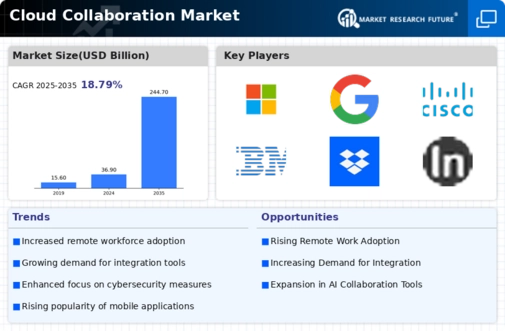Advancements in Cloud Technology
Technological advancements play a crucial role in shaping the Cloud Collaboration Market. Innovations in cloud computing, such as improved storage capabilities and enhanced processing power, enable organizations to leverage sophisticated collaboration tools. The integration of advanced features, such as real-time editing and file sharing, enhances user experience and productivity. Market data suggests that the adoption of cloud technologies is projected to grow at a compound annual growth rate of 15 percent over the next five years. This growth is indicative of the increasing reliance on cloud-based solutions for collaboration, as businesses recognize the benefits of scalability and flexibility. Consequently, the Cloud Collaboration Market is likely to witness a proliferation of new tools and services designed to meet the evolving needs of users.
Growing Emphasis on Data Security
In the Cloud Collaboration Market, data security has emerged as a critical concern for organizations. As businesses increasingly rely on cloud-based collaboration tools, the potential risks associated with data breaches and cyber threats become more pronounced. Recent studies indicate that nearly 60 percent of organizations prioritize security features when selecting collaboration platforms. This heightened focus on data protection drives service providers to enhance their security measures, including encryption and multi-factor authentication. The Cloud Collaboration Market is thus witnessing a shift towards solutions that not only facilitate collaboration but also ensure the integrity and confidentiality of sensitive information. As organizations navigate the complexities of data security, the demand for secure collaboration tools is expected to rise, influencing market dynamics.
Rise of Mobile Collaboration Tools
The proliferation of mobile devices has significantly influenced the Cloud Collaboration Market. As employees increasingly rely on smartphones and tablets for work, the demand for mobile collaboration tools has surged. Recent statistics reveal that over 80 percent of professionals utilize mobile applications for collaboration, highlighting the necessity for solutions that cater to on-the-go users. This trend underscores the importance of accessibility and convenience in the Cloud Collaboration Market. Service providers are responding by developing mobile-friendly platforms that offer seamless functionality across devices. The rise of mobile collaboration tools not only enhances productivity but also fosters a culture of flexibility and responsiveness within organizations. As mobile collaboration continues to gain traction, the market is poised for further growth.
Integration of Artificial Intelligence
The integration of artificial intelligence (AI) technologies is transforming the Cloud Collaboration Market. AI-driven features, such as automated scheduling, intelligent document management, and predictive analytics, enhance the functionality of collaboration tools. These innovations streamline workflows and improve decision-making processes, making collaboration more efficient. Market analysis indicates that the adoption of AI in collaboration tools is expected to increase significantly, with projections suggesting a growth rate of 20 percent annually. This trend reflects the growing recognition of AI's potential to optimize collaboration and drive productivity. As organizations seek to leverage AI capabilities, the Cloud Collaboration Market is likely to see a surge in demand for advanced collaboration solutions that incorporate intelligent features.
Increased Demand for Remote Work Solutions
The Cloud Collaboration Market experiences a notable surge in demand for remote work solutions. As organizations increasingly adopt flexible work arrangements, the need for effective collaboration tools becomes paramount. According to recent data, approximately 70 percent of companies are investing in cloud-based collaboration platforms to enhance productivity and communication among remote teams. This trend indicates a shift towards digital transformation, where businesses prioritize seamless connectivity and real-time collaboration. The Cloud Collaboration Market is thus positioned to benefit from this growing demand, as organizations seek to implement solutions that facilitate teamwork regardless of geographical barriers. The emphasis on remote work solutions is likely to drive innovation and competition among service providers, further expanding the market landscape.


















Leave a Comment